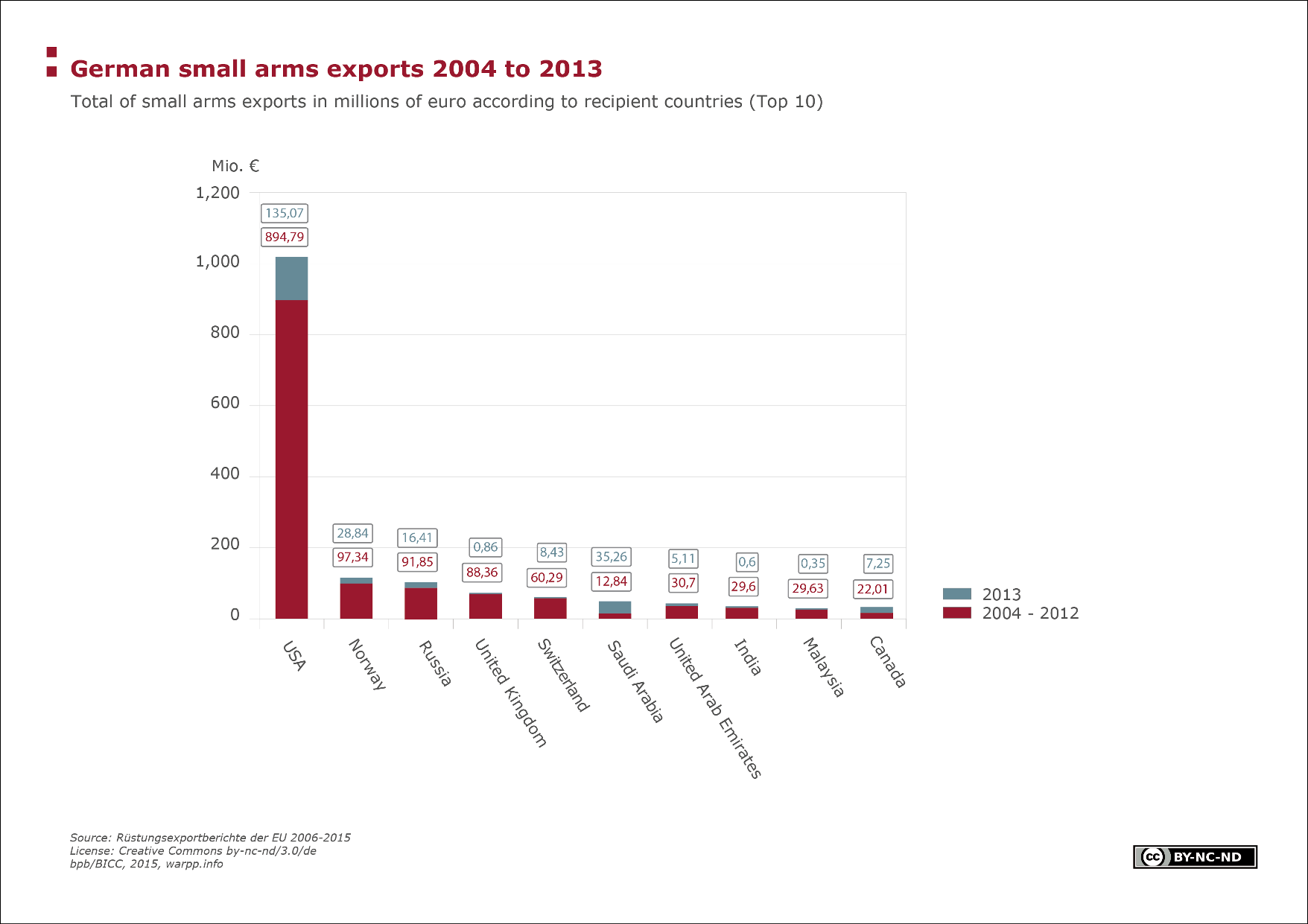German small arms exports 2004 to 2013

The graph shows the sum of German small arms exports for 2004 to 2013 exemplary of the top 10 SALW importing countries who showed the highest value of goods for the reported period The red columns show the total of export values for 2004 to 2012; the blue columns the export value for 2013. The values for SALW that were exported to the United States differ markedly from those to Norway, which, with less than one-fifth of export volume, are in second position.
Facts
In 2013, Germany exported SALW worth 285,899,352 euro After the United States and Italy, it is the third-largest exporter in terms of value of goods The export of SALW is controlled in German law by the law on the control of weapons of war ('Kriegswaffenkontrollgesetz'). In EU law, the export of war materials is controlled by the EU Common Position 2008/944/CFSP. All member states must be informed of export licenses of war materials; these licenses ought to be granted in accordance with eight criteria.
Small arms are often used in non-state conflicts and are the weapons preferred by criminals and politically motivated groups. While individually, small arms cannot compete with the destructive power of weapons of mass destruction, as a whole, they are highly destructive: An estimated 50,000 to 100,000 people are 'direct' victims of small arms every year; added to this must be the 'collateral deaths', about twice the amount. A number of characteristics of small arms contribute to this: Small arms are relatively cheap and easily available; small arms can be hidden and smuggled easily; small arms are extremely easy to maintain and have a long service life—even after many decades, they can still be operational.
Terms, notes on methodology or reading aids
Small arms and light weapons are portable arms with a calibre of up to 100mm. They range from revolvers and pistols, assault rifles and machine guns to grenade launchers and MANPADS (man-portable air defence systems). Small arms are firearms that have been designed for the use by one person and have a calibre of up to 12.7 mm, while light weapons have a higher calibre (12.7 to 100 mm) and are operated by a team of two or three. Their acronym is SALW.
Arms export data from different sources are difficult to compare as there is no unified way that countries collect and transfer data on their exports. They report at different times and for different weapon categories
Data sources
EU Arms Exports Reports 1999 to 2014 In 1998, in the framework of the Common Foreign and Security Policy of EU Member States, a code of conduct for arms exports was adopted that, however, is not legally binding. In 2008, this code of conduct was integrated into the Common Position No 944. All members have agreed to abide by them and that they will integrate it into national law. Core element of the Common Position are eight criteria regarding arms exports licenses and the commitment to present an annual arms exports report. The eight criteria lay down when trade or the movement of military goods and weapons is permitted. A final decision on whether a country wants to finally permit the transfer of military technology, however, is up to each individual nation. These annual export reports are intended to improve transparency in arms deals. In these reports, each country lists its exports of military weapons and military equipment according to the country of destination. These goods are divided into 22 categories Small arms exports are recorded in category ML1 : "Smooth-bore weapons with a calilbre of less than 20mm, other arms and automatic weapons with a calibre of 12.7mm (calibre 0.50 inches) or less and accessories, as follows, as specially designed components therefor."





